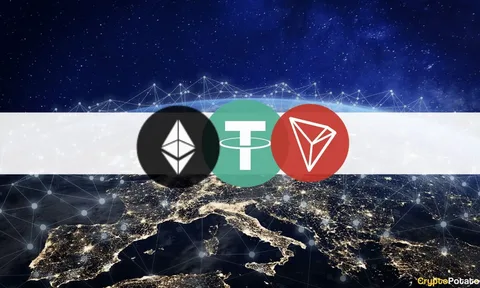Ethereum, a pioneer in blockchain technology, has made another remarkable leap. In the realm of stablecoins, Tether (USDT) remains the leading asset, dominating the global cryptocurrency ecosystem.
However, it recently surged ahead, capturing 44.56% of Tether’s supply, overshadowing Tron, its closest competitor. This development underscores it’s continuing relevance and adaptability in the ever-evolving cryptocurrency market.
This blog post dives deep into Ethereum’s ascendancy in the stablecoin space, analyzing how it outpaced Tron in capturing Tether’s supply. We’ll explore the historical context, technical factors, market trends, and what this shift means for the broader cryptocurrency ecosystem.

Ethereum’s Historical Journey with Tether: A Longstanding Relationship
Since its inception, it has played a crucial role in hosting Tether. Initially launched on Bitcoin’s Omni Layer, Tether transitioned to Ethereum in 2017 due to the latter’s scalable and versatile ERC-20 standard. This move revolutionized how stablecoins operate, enabling seamless integration into Ethereum-based decentralized applications (dApps).
Tether’s compatibility with it has been instrumental in propelling the network forward, with USDT becoming a vital trading pair across decentralized finance (DeFi) platforms. it’s dominance in DeFi allowed it to hold a significant share of Tether’s supply, positioning itself as a critical player in the stablecoin market.
However, Ethereum’s dominance faced a challenge from Tron, a blockchain network known for its lower transaction fees and faster processing times. By late 2020, Tron began attracting a larger portion of Tether’s supply, threatening it’s stronghold. Fast forward to 2024, and it’s surge in recapturing 44.56% of Tether’s supply marks a significant shift, reaffirming its resilience and adaptability.
Factors Driving Ethereum’s Surge in Capturing Tether Supply
1. Scalability Improvements Through Ethereum 2.0
The Ethereum network has undergone significant upgrades, culminating in Ethereum 2.0. By transitioning from a proof-of-work (PoW) to a proof-of-stake (PoS) consensus mechanism, it has drastically reduced transaction costs and improved scalability.
These upgrades made the network more appealing for stablecoin transactions, particularly for institutional players and retail users seeking reliability. Unlike Tron, which relies on faster block times to attract users, Ethereum’s improved scalability ensures long-term network stability without compromising decentralization.
2. DeFi and Smart Contract Ecosystem
Ethereum’s extensive ecosystem of dApps and DeFi platforms continues to be a major draw for Tether users. While Tron offers faster transactions, it provides a much broader utility, enabling users to stake, lend, borrow, and trade Tether in decentralized environments.
For instance, platforms like Uniswap, Aave, and Curve Finance heavily utilize USDT in liquidity pools, further cementing it as the network of choice for stablecoin integration. These use cases contribute to the surge in it’s ability to capture Tether supply.
3. Institutional Adoption and Market Trust
Ethereum has consistently attracted institutional investors, and this trust extends to its stablecoin integrations. Tether, being the largest stablecoin, benefits from it’s robust infrastructure and market credibility.
As more enterprises explore blockchain adoption, they prioritize networks like it that offer security, transparency, and extensive developer support. This institutional preference has significantly bolstered it’s share of Tether’s supply.
Tron’s Role and Challenges in the Stablecoin Ecosystem
While Ethereum surges ahead, it’s important to acknowledge Tron’s role in the stablecoin market. Tron emerged as a cost-effective alternative, providing near-instant transactions with negligible fees, which attracted Tether issuers. By 2021, Tron had claimed over 50% of Tether’s supply, challenging it’s dominance.
However, Tron’s reliance on low transaction fees has also been its Achilles’ heel. Critics argue that Tron’s consensus mechanism sacrifices decentralization for speed. This trade-off has made it less appealing to users prioritizing security and decentralization, particularly in the wake of rising regulatory scrutiny on stablecoin networks.
Moreover, it’s recent advancements, including layer-2 solutions like Arbitrum and Optimism, have minimized Tron’s competitive edge in transaction costs and speed. These improvements have allowed it to reclaim a larger share of Tether’s supply.
What This Means for the Broader Cryptocurrency Ecosystem
Ethereum’s resurgence in the stablecoin market signals broader implications for the cryptocurrency ecosystem.
1. Strengthening of DeFi
As it captures more of Tether’s supply, it bolsters the DeFi sector, ensuring that stablecoins remain integral to decentralized financial systems. This strengthens it’s position as the backbone of DeFi.
2. Competition Driving Innovation
Tron’s past success forced it to innovate, resulting in significant network upgrades. This healthy competition drives both networks to improve their offerings, benefiting users and developers alike.
3. Regulatory Considerations
Ethereum’s established reputation and ongoing efforts to enhance transparency position it favorably in regulatory discussions. Stablecoin adoption within compliant frameworks could further consolidate Ethereum’s dominance.
Conclusion: A New Era of Stablecoin Integration
Ethereum’s surge in capturing 44.56% of Tether’s supply is a testament to its resilience, adaptability, and unmatched ecosystem. By outpacing Tron, Ethereum has reaffirmed its position as a leader in the blockchain industry, paving the way for new opportunities in DeFi, dApps, and beyond.
As we witness this pivotal moment in stablecoin history, what do you think the future holds for Ethereum and Tron in this space? Will it maintain its lead, or will Tron make a comeback? Share your thoughts in the comments below—we’d love to hear your perspective!






